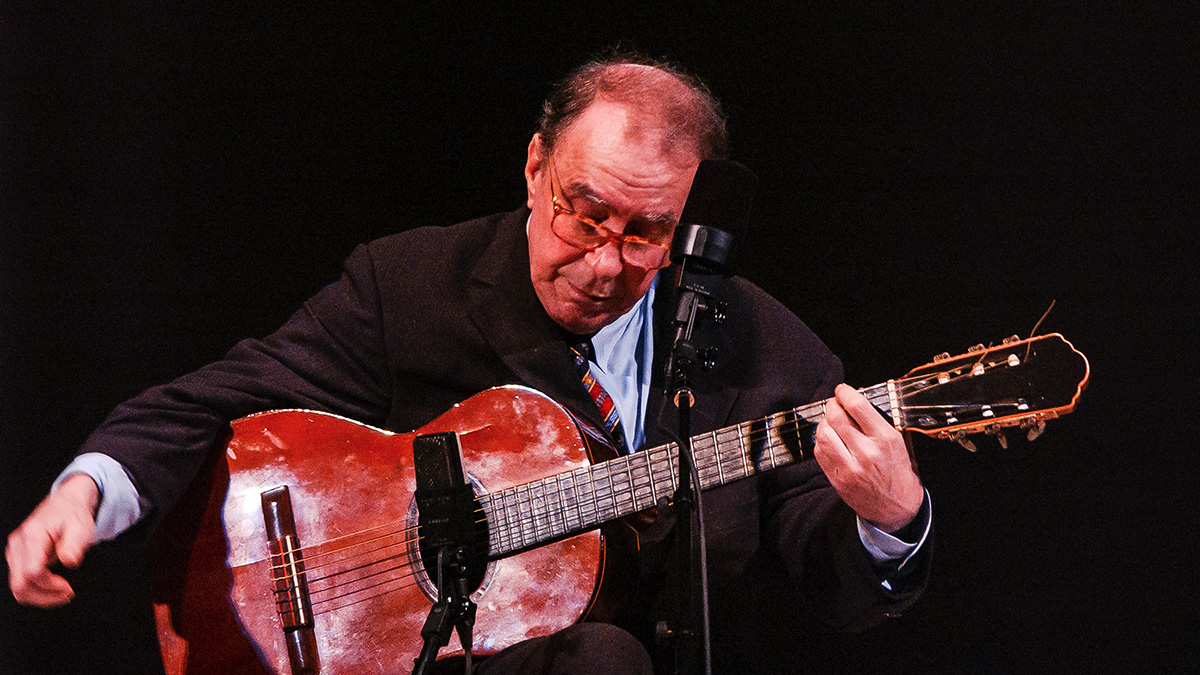Learn the vibrant guitar styles of bossa nova, tango and rumba with this lesson in South American rhythms
Expand your musical vocabulary with this guide to six of the most important South American guitar styles

Welcome to our feature designed to explore a range of South American rhythms. Each has its own name and own particular sound, and its performers are highly proud and protective of each one’s authenticity.
What I hope you’ll gain from the lesson are some core techniques and concepts to help you build a vocabulary in these vibrant styles. We have chosen six contrasting rhythms from this exciting continent, and for each we have recorded a 16-bar performance piece, with backing track to practise along with.
The guitar plays an important role in these styles but we can also adapt typical piano parts onto the guitar. A nylon-string guitar is stylistically effective and appropriate for playing these styles, but any guitar can be used so there is no excuse not to get involved.
When studying South American music, it’s helpful to know how each of the instruments in the ensemble functions. There are even specific names applied to each instrument’s function within the arrangement.
The ‘clave’ is a rhythmic pattern typically used in Afro Cuban music styles (salsa, cha cha cha, mambo, rumba, samba, etc). The five-stroke clave rhythm forms the backbone of the rhythm section. We have written out two of the most popular claves to study.
The ‘cascara’ rhythm (it means ‘shell’ and was originally played on the side or ‘shell’ of the timbale drums. Drummers often play cascara rhythms on various parts of the kit and this adds to the complexity of the sound.
The syncopated (off-beat) piano figures commonly heard in South American music are often referred to as a ‘montuno’. These syncopated lines often repeat over and over, and incorporate chromatic passages and octave intervals. Transferring these piano ideas to the guitar can be challenging, as their syncopated nature adds extra difficulty if you are not use to playing, ‘off the beat’.
Finally, in Afro-Cuban styles the bassline is often referred to as the ‘tumbao’. The ‘tumbao’ can be confusing to listen to if you are a rock and pop musician as the bassline often starts on beat four of the bar. Basslines in rock music generally feel most solid when they start on beat one, so it’s important when playing in a style with a ‘tumbao’ bassline to remember where the start of the bar is.
Next up is a list of the six styles that we are going to look at in this feature, complete with information on their origins as well as a few of their idiosyncrasies.
Style 1 – Samba
Samba is a Brazilian music style that gave birth to the bossa nova. The music is usually up-tempo and rhythmically complex. At carnival time large groups of musicians (often between 250 and 300) play together accompanying the dancing ‘samba schools’.
This music is mostly percussion based with various rhythms and percussion instruments intertwining to produce one, enormous wall of sound. The style can also be adapted to work in a small combo and we’ve had fun composing a fast-paced, catchy samba track.
Style 2 - Bossa Nova
The Brazilian bossa nova became popular in the 1960s and is a fusion of samba and jazz. The tempo is more laid-back and mellow than samba, and bossa nova has become part of popular modern jazz repertoire.
The composer Antonio Carlos Jobim has written many classic songs including The Girl From Impanema. The rhythms are based around the bossa clave (Fig 1). This two-bar pattern can be played with three beats in the first bar, and two beats in the second (3:2 clave) or reversed so that there are two beats in bar one, and three beats in bar two (2:3 clave).
Style 3 – Rumba
The Cuban rumba is a fusion of music brought to Cuba by African slaves and Spanish settlers. This style features the ‘tumbao’ bass line and is fun to play. Blues musicians like Robben Ford and Albert King are fond of the rumba feel and have often incorporated it into their arrangements.
The rhythms are based around the underpinning ‘rumba clave’ (Fig 1) which can be played in the 3:2 or 2:3 formats.
Style 4 – Merengue
The merengue originated in the Dominican Republic and was created in the 1920s by Nico Lora. The style is up beat and the lyrics and dance styles are often suggestive. One of the most popular styles of merengue is named after the brothel it is said to have started in (perico ripiao). There are three different types of merengue played in the Dominican Republic today.
Style 5 – Bachata
Bachata is another rhythm from the Dominican Republic. It combines African elements with Latin and Caribbean rhythms, and the music has developed to include electric guitar. This modern electric version of bachata has become very popular.
Style 6 – Tango
The tango originated in Argentina and has had a massive influence on the western music scene. The tango style is heavily associated with dance, and the tango is a popular discipline within ballroom dancing, as those who watch ‘Strictly’ will know.
Tango music often uses a 4/4 time signature and is performed with a fiery delivery and a driving feel.
Coming up you’ll find an audio demonstration of all six styles with a backing track to practice over. You can also use the backing tracks to practice your own ideas.
Technique Focus: The South American Clave
The ‘clave’ is a rhythmic pattern typically used in Afro Cuban music styles (Salsa, Cha Cha Cha, Mambo, Rumba, Samba etc.). The five-stroke clave rhythm is two bars long and forms the backbone of the rhythm section.
The name ‘claves’ is also used for a percussion instrument that consists of two woodblocks that are banged together. The ‘clave’ rhythm underpins the music in very much the same way the pulse does. It is often implied by the rhythm section, as opposed to being played in an obvious way. Each style has it’s own ‘clave’, and we have written out two of the more common ones for you to study (see fig 1-2).
The ‘clave’ rhythm underpins the music in very much the same way the pulse does. It is often implied by the rhythm section, as opposed to being played in an obvious way
Each clave has two variations. The 3;2 and the 2;3. This numbering refers to how many beats are in each of the two bars. We have recorded these (see fig 1) with the rhythms played on a wood block to listen to. These classic rhythms will help your internal clock and develop good time keeping.
This approach also adds a natural accent to beats two and four. You may find it hard to practice this way to start with as most find placing the accent on beat two and four tricky. Persevere, though!
Get the tone
Amp Settings: Gain 3, Bass 7, Middle 6, Treble 9, Reverb 0
The ideas in this article can be played on any type of guitar, but they will sound and feel most authentic on an acoustic guitar. A nylon-string is the firm favourite, but for more modern styles like bachata we used an electric guitar. When playing nylon-string, well-maintained fingernails can help with both the quality and consistency of your tone.
Piece 1. Samba
This samba style piece skips along at a fast pace (220bpm) so you will need to practise slowly in preparation to playing at the performance tempo. The chords are based around a I-VI-II-V progression in C (C-Am-Dm-G).
The chords and alternating bassline are combined and this part is best played using fingerstyle technique. To finish off there is also a lead guitar melody to learn. A key feature is the syncopated (off-beat) nature of the rhythms that are used in samba.
Piece 2. Bossa Nova
The bossa nova has a lovely feel and uses sophisticated jazz-style harmony. This piece has a fairly complex rhythm part to learn, which again incorporates the bassline and chords together. Check out the picking pattern in the tab and take it slowly, as this may take some practice to perfect. The lead part outlines the prime tones of the chords as they pass.
For the G7#5 in bar 18, we superimposed an Ab major arpeggio to provide an ‘altered’ sound.
Piece 3. Rumba
This piece has a fast, rumba groove with a tumbao bassline. The guitar part is a montuno style pattern incorporating the bassline with syncopated rhythms. This piece can be played fingerstyle, but hybrid picking (pick and fingers) will also work well, especially if you are playing on a guitar with steel strings.
It’s important to start these pieces slowly and work up to speed gradually. We have included a lead passage to learn and again the emphasis is on syncopation. Bars 11-12 also feature a harmonised part. For this simply play the notes in the tab and let the backing track do the work.
Piece 4. Merengue
Our merengue piece is fun to play but challenging due to the fast tempo. The open first string provides a pedal tone, and it’s well worth experimenting with the suggested fingerings with a view to keeping the open-string notes clear and unmuted. Practise both hands slowly and then build the parts up to tempo.
Piece 5. Bachata
The bachata is an emotive style and this guitar part is relatively easy to play but very effective. In bars 3-5 the same figure is repeated with the bass note changing each time. This evokes the desired hypnotic sound, so concentrate on keeping your feel and tone consistent. A key feature of the lead part is repetition.
Piece 6. Tango
The first chorus’s simple melody helps both performer and listener engage. Take your time learning the parts and look at the suggested fingerings. The second chorus is essentially a repeat of the first, only this time the melody has been embellished.
Check out the fast trills and make sure the legato notes are loud and clear. Play the piece fingerstyle, which may prove tricky if you are not used to the technique. If so, take it slowly and build the tempo gradually.
Get The Pick Newsletter
All the latest guitar news, interviews, lessons, reviews, deals and more, direct to your inbox!
Jon Bishop is a UK-based guitarist and freelance musician, and a longtime contributor to Guitar Techniques and Total Guitar. He's a graduate of the Academy of Contemporary Music in Guildford and is touring and recording guitarist for British rock 'n' roll royalty Shakin’ Stevens.









![Joe Bonamassa [left] wears a deep blue suit and polka-dotted shirt and plays his green refin Strat; the late Irish blues legend Rory Gallagher [right] screams and inflicts some punishment on his heavily worn number one Stratocaster.](https://cdn.mos.cms.futurecdn.net/cw28h7UBcTVfTLs7p7eiLe.jpg)

